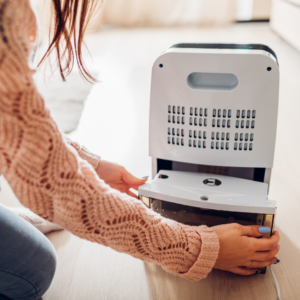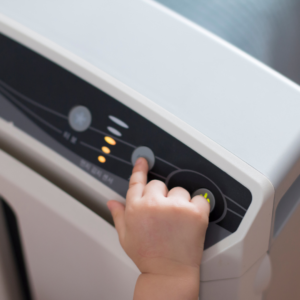
In this article, we will look at dehumidifiers and how they can help fix and prevent a mold issue. We will talk about types of dehumidifiers, how they work, where they go, and why they are useful. We will also learn about how mold grows and spreads as well and what you can do to ensure your dehumidifier unit doesn’t make things worse. Most importantly we will ask: will a dehumidifier help with mold?
Mold issues and illnesses are on the rise in the modern age. It’s worth looking at how to prevent mold from growing in your home as mold can cause many health problems like a disease of the respiratory system, allergies, asthma, skin rashes, headaches, and can even be deadly for those with compromised immune systems. Mold grows when excess humidity (ex. water leak) is present along with enough food for mold to eat and space void of other microbial competitors.
Mold issues and illnesses are on the rise in the modern age. It’s worth looking at how to prevent mold from growing in your home as mold can cause many health problems like a disease of the respiratory system, allergies, asthma, skin… Share on XAlthough a dehumidifier can’t solve all mold problems, it certainly is a great prevention strategy and works well to control mold in combination with mold remediation or prevention techniques.

A humidifier is a device that adds more moisture to the room air inside household spaces. People use humidifiers for the specific purpose of adding more humidity and moisture inside a home.
Mold requires the following conditions in order to grow – moisture, food, and space void of other competitors. A humidifier helps reduce the dryness in the air but adds more humidity to a room. So, unfortunately, no humidifier does not prevent mold and in fact, may only increase the moisture level in household areas. There’s no point in adding another moisture source to your home if you’re trying to prevent or remove mold.
Unfortunately, humidifiers will not get rid of mold. Instead, they may add to a current mold problem or can even cause one. Also, since mold needs moisture to grow, you can even find mold growing inside humidifier units. If you’re trying to prevent or kill mold then you need to remove the moisture from the air rather than adding to it. Humidifiers are only necessary when the air inside a room is so dry that it’s causing significant health problems. However, health problems will only get worse if a humidifier activates more mold growth in the home. If you’re trying to get rid of mold or prevent mold growth, a humidifier may not be the best solution to the problem.
 Will A Dehumidifier Kill Mold?
Will A Dehumidifier Kill Mold?A dehumidifier is a device that removes excess humidity and moisture from the air. People use dehumidifiers for the express purpose of removing water, condensation, humidity, and moisture from the home environment.
Many people ask – does a dehumidifier kill mold? The answer is no, dehumidifiers don’t have the capacity to kill mold. Mold grows by reproducing spores into the air. Those spores land on surfaces and if there’s moisture, food, and space, the mold spores will grow. Dehumidifiers can remove moisture but they can’t actually kill mold spores or active mold growing on surfaces. These units also can’t do anything about mildew in kitchens and bathrooms. However, when included with other interventions, it can absolutely help prevent mold in the home.
A refrigerant dehumidifier works like condensation on a window. It features a refrigeration system that creates a cold area that is colder than room air. As air is drawn into the unit, it draws moisture out of the air and condenses it into a separate compartment.
Desiccant dehumidifiers use a silica-like gel to draw and trap moisture out of the air. Air is drawn into the unit and passed over the silica where moisture is drawn into the material. These units are typically used when the air needs to be very dry.
Both units are effective for removing excess moisture and humidity from the air. Refrigerant units work well for buildings that have plaster and concrete that needs to be kept dry. Desiccant units are best suited for environments where moisture absolutely must be kept to a minimum such as pharmaceutical buildings. Desiccant units are also good for places where access is limited like storage tanks.
The best dehumidifier would have a mix of refrigerant and desiccant properties. They balance each other out and effectively remove large amounts of moisture and humidity from the air inside the home.
 What Type Of Dehumidifier Is Best To Get Rid Of Mold?
What Type Of Dehumidifier Is Best To Get Rid Of Mold?In terms of getting rid of mold and mildew, no dehumidifier is going to help with that. Although dehumidifiers can effectively prevent mold, they can’t kill mold spores or an already established mold problem inside the home. It’s important to consult a professional when determining how to get rid of an established mold issue. You will likely need professional mold remediation. In the case of mildew, you can use hydrogen peroxide and wipe those surfaces.
As we discussed above, mold needs three conditions in order to grow – moisture, food, and space to grow without competitors. In order to stop mold from growing, we need to prevent all three conditions from happening. Limiting food is difficult as mold can eat many things readily available in our home. These are things like drywall, paper, furniture, cloth, dead skin cells, other microbes, etc. However, we can do a lot to prevent moisture build-up and ensure there are competitors to limit space for mold growth.
Mold needs three conditions in order to grow - moisture, food, and space to grow without competitors. In order to stop mold from growing, we need to prevent all three conditions from happening. Share on XThe following are ways to reduce moisture:
Lastly, to increase the number of competitors for mold we can do the following:
 Which Type Of Humidity Grows Mold?
Which Type Of Humidity Grows Mold?Actually, any humidity or moisture can be used by mold spores to propagate and grow. Humid air contains microscopic water particles and if there’s too much of it in your home, mold can use it to grow. Likewise, water sources such as condensation, water leaks, and water damage can all cause mold to grow. It can also cause mildew to build up at well. Humidity can be found in all areas of the house including the basements, kitchen, bathrooms, water tank, and attic.
All kinds of mold species can and will grow if conditions are right, including high humidity levels. There are thousands of mold species but the most common ones are aspergillus, cladosporium, fusarium, and stachybotrys. All mold species have the potential to add allergens to household spaces and cause health issues like allergy symptoms, asthma, skin rashes, and other allergy triggers. However, stachybotrys, or black mold as it’s commonly called, is a very toxic mold and should be removed by a professional mold removal company.
All kinds of mold species can and will grow if conditions are right, including high humidity levels. There are thousands of mold species but the most common ones are aspergillus, cladosporium, fusarium, and stachybotrys. All mold… Share on XYes, dehumidifiers can be a source of mold and can spread mold in other parts of the house. In the case of refrigerant dehumidifiers that hold water in the unit, this moisture source can be a breeding ground for mold if it’s not removed or cared for properly. Even though these dehumidifiers can help decrease humidity in the house, they need to be cared for properly. Be sure to check all the operating and cleaning instructions upon purchasing a dehumidifier. Adhering to those instructions will ensure that the dehumidifier will not hold and propagate mold spores.
 Will Mold Die If Moisture Is Removed?
Will Mold Die If Moisture Is Removed?The goal of dehumidifiers is to reduce the relative humidity in a home. This will help prevent or reduce a mold problem but it will not kill mold once it has taken hold inside the house. The problem is that mold spores have a survival tactic whereby they go dormant when they don’t have enough food or humidity to help them propagate. In this way, they’re able to survive for long periods of time; waiting it out unless the arrival of more food and humidity. However, if a home is void of any mold, a dehumidifier can reduce the humidity level in a home which is an effective strategy to keep mold growth at bay.
Other strategies to reduce humidity levels are to ensure there is enough ventilation in the home without causing too much condensation in the cooler weather. If the weather outside is cold, there will be more humidity around the windows and doors, especially if the home is very warm inside. It’s best to keep a warm room temperature in the home, but not too warm. In this case, a dehumidifier works well to decrease relative humidity inside the house.
Ideally, a dehumidifier would be purchased before any signs of mold are present. In the case of mold control, it’s best to stop mold before it starts. However, if mold is present or a musty mildew smell is detected in the house, a dehumidifier can help reduce the problem in combination with other interventions. In areas of the house that tend to have a lot of water and higher humidity levels such as a basement, attic, AC units, kitchen, water tank, and bathrooms, or anywhere that has excess moisture, a dehumidifier can really help. Also if there has been a water leak anywhere inside the house, be sure to fix that problem first and then use a dehumidifier to prevent any problems from happening. Mildew often grows in kitchens and bathrooms due to a lot of water content, so you’ll want to pay attention to those areas as well. The good thing is that mildew doesn’t cause as much damage like mold. Once mold damage takes place, a dehumidifier won’t help much. At that point, a mold remediation company should be called in to help remove the mold and fix the damage.
A dehumidifier prevents mold by decreasing relative humidity and moisture levels in the home. You don’t necessarily need one in every room, however, you may need multiple units if there are many areas of the house that have high humidity levels. By placing a dehumidifier ahead of time, meaning before any mold growth or moisture damage takes place, it can significantly help prevent mold problems from taking hold. Consider a dehumidifier one of a few strategies to keep mold growth from becoming a problem in the home. You can check if your dehumidifier is working by placing a hygrometer in the room or area where you want to reduce the humidity level.
For large rooms (ex. basement) that may have water damage or leaks, you will want to choose the largest units with a few features like an air filter or purification system, energy star certified (to reduce energy consumption), a defrost feature, a fan (with a good amount of fan speed) auto shutoff, humidistat, and other benefits. These units will provide the best function and service for what you need in large damp rooms. It may be good also to get a unit that has a combined refrigerant and desiccant system.
 Is A Dehumidifier Enough For Dealing With Mold?
Is A Dehumidifier Enough For Dealing With Mold?No, a dehumidifier alone is not enough to deal with mold. It’s a fantastic preventative, but it won’t kill mold or stop a mold problem on its own. A dehumidifier can help prevent mold in rooms that have high humidity but don’t have mold growth yet. A dehumidifier, along with other interventions can help reduce a mold problem, but it can never be relied upon as the only intervention.
So, will a dehumidifier solve my mold problem?
A dehumidifier can help solve a mold issue in combination with other interventions such as mold remediation, air ventilation, fixing or preventing water leaks, enhancing the home microbiome, and decreasing clutter around moist areas. However, relying on a dehumidifier alone can be very faulty thinking and likely won’t work.
In conclusion, a dehumidifier is a fantastic way to help prevent and fix a mold issue. It’s one of the best courses of action for mold prevention and control, but it will not kill mold or its spores. This is important to know as many people often buy dehumidifiers hoping to kill mold in their home and it doesn’t quite work that way. But it can help reduce it and prevent it.
https://pubmed.ncbi.nlm.nih.gov/16268830/
https://www.pnas.org/content/110/46/18360?etoc=
https://www.sciencedirect.com/science/article/abs/pii/S0013935115000304
https://erj.ersjournals.com/content/44/Suppl_58/P1187
https://www.jacionline.org/article/S0091-6749(13)01564-9/fulltex
https://pubmed.ncbi.nlm.nih.gov/19201053/
https://www.sciencedirect.com/science/article/abs/pii/S1471490615000022
https://pubmed.ncbi.nlm.nih.gov/5105267/
https://www.ncbi.nlm.nih.gov/pmc/articles/PMC6472009/

Gillian is a former nurse and joined the Homebiotic team as a researcher & science writer. She loves traveling the world and currently lives in Colombia.